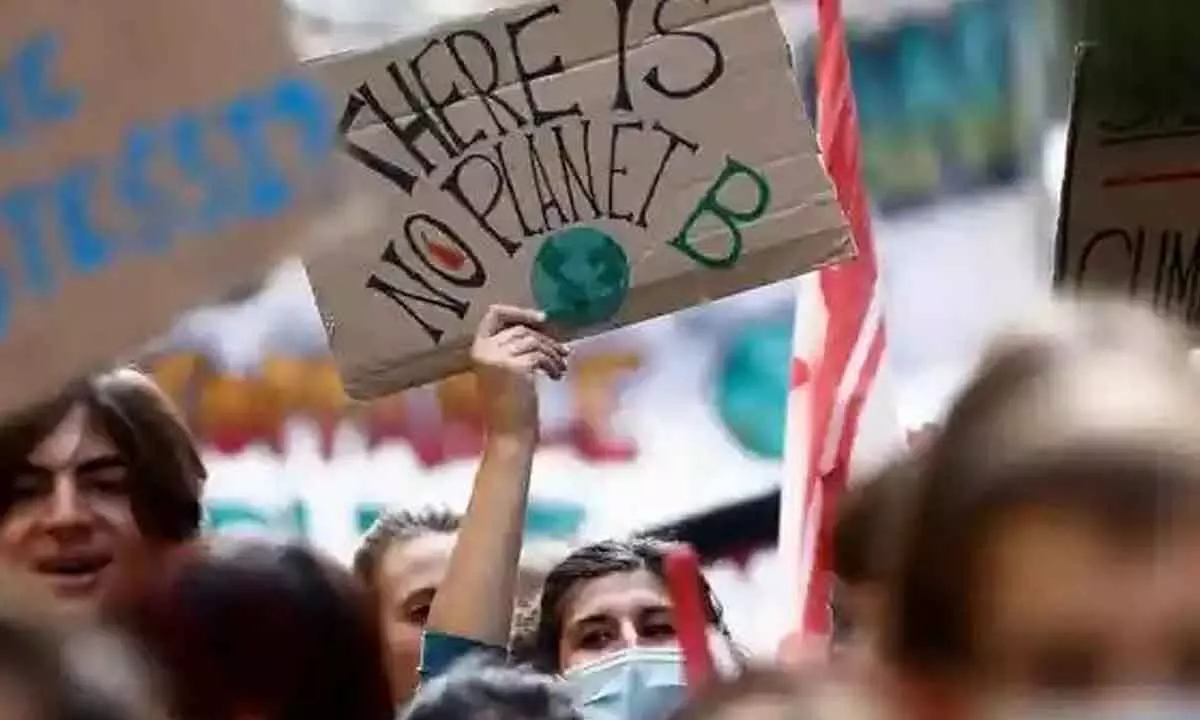Live
- They always want me to win, and now I feel lucky to have been offered a story like ‘Zebra’: Satyadev Kancharana
- ‘Democracy first, humanity first’: PM Modi in Guyana's parliament on two countries' similarities
- PKL Season 11: Telugu Titans register third straight win to top standings
- Is Pollution Contributing to Your COPD?
- NASA Unveils Underwater Robots for Exploring Jupiter's Moons
- Additional Central forces arrive in violence-hit Manipur
- AR Rahman and Saira Banu’s Divorce: Legal Insights into Common Issues in Bollywood Marriages
- 82.7 pc work completed in HPCL Rajasthan Refinery area: official
- Curfew relaxation extended in 5 Manipur districts on Friday
- Tab scam prompts Bengal govt to adopt caution over fund disbursement
Just In

The findings and the political outcome must inform the next round of countries’ pledges to cut emissions, due in 2025. It is a key part of how the Paris agreement tries to “ratchet up” climate ambition, though how this stocktake will raise ambition is also still up for debate
As the world gathers in the United Arab Emirates for the annual UN climate change conference (or, more formally, Conference of the Parties, COP), the stakes are as high as ever. The head of the UN climate change secretariat Simon Stiell has urged for this meeting – COP28 – to be a “turning point.”
Can this COP deliver on that goal? Perhaps. Here are the key issues at stake this time round:
1. Whether host really matters
Does it matter that the host country is a major oil producer, and the COP president, Sultan Al Jaber is the head of the UAE’s national oil company? Yes and no. Optics-wise, it’s not great. The UAE is host because the COPs follow a regional rotation. When the Asia-Pacific region was due to select its host country, during the pandemic, only the UAE ultimately stepped forward. There are legitimate worries and already evidence of a conflict of interest.
Yet a COP president is a constrained actor. It can facilitate and provide support, but cannot set the agenda or nullify any views put forward. Countries are quick to jump on someone seen to be overstepping their bounds, and not facilitating a “party-driven process.” Informally, the COP president can set more or less ambitious goals for the meeting and help broker better deals for the planet. Ultimately though, it is up to countries to deliver.
2. A fight over the agenda
A coalition called the Like-Minded Group of Developing Countries (LMDC) has brought forward several suggestions. The group, which includes China, India, Saudi Arabia and Bolivia among others, has proposed negotiations on doubling adaptation finance, as agreed in Glasgow in 2021, and urgently scaling up financial support from developed countries.It was only last year that developed countries finally met their 2010 promise to provide US$100 billion per year by 2020. This is one reason why trust between countries is low.
The last LMDC suggestion may be the most controversial. When the UN framework convention on climate change was adopted in 1992, the world was clearer: there were developed and developing countries that were easily distinguished. The LMDCs and others want to protect this split and point to the historic responsibility of wealthier western countries. In their view, rich countries should be providing more climate finance. The US and other developed countries want more of a spectrum, where countries act in light of their own national circumstances and capacities. They point to the emissions of countries like China and India and call for commensurate action, even in providing finance to other countries.
3. Global stocktake
This is an important year for the Paris agreement, signed in 2015, as it’s the first ever global stocktake. This is a look at how countries are doing on reducing emissions, building climate resilience, and supporting developing countries. It will likely deliver a sobering inventory of countries’ collective efforts.
Following a year-and-a-half long technical phase to gather inputs, the stocktake is now in the political phase where countries must decide what to say about the findings. The field is open. This exercise hasn’t happened before so there isn’t a blueprint to follow. Countries could identify priority areas for action, or set goals, such as doubling renewable energy capacity.
The findings and the political outcome must inform the next round of countries’ pledges to cut emissions, due in 2025. It is a key part of how the Paris agreement tries to “ratchet up” climate ambition, though how this stocktake will raise ambition is also still up for debate. They have just two weeks to negotiate and the current, bullet-point-only draft shows that parties are very far apart.
4. Phasing down fossil fuels
It was a new idea to specifically mention coal and fossil fuel subsidies in the 2021 Glasgow climate pact. While reducing emissions is a key part of climate discussions, the focus is often on measures like avoiding deforestation or trading permissions to emit carbon rather than simply not emitting it in the first place. In the run up to COP28, there have been calls by countries to either phase out or phase down fossil fuels, or maybe to specify “unabated” fossil fuels (where unabated could mean many things). This language would be groundbreaking. But, it’s important to remember that many of its proponents are still actively investing in fossil fuels.
No one COP will save the planet. But this one could help ratchet up climate action in the immediate future. With much left in the air and trust among countries low, COP28 may struggle to meet even the expectation to act as a turning point.
(Writer is Lecturer in Environmental Politics, Cardiff University, UK)

© 2024 Hyderabad Media House Limited/The Hans India. All rights reserved. Powered by hocalwire.com







